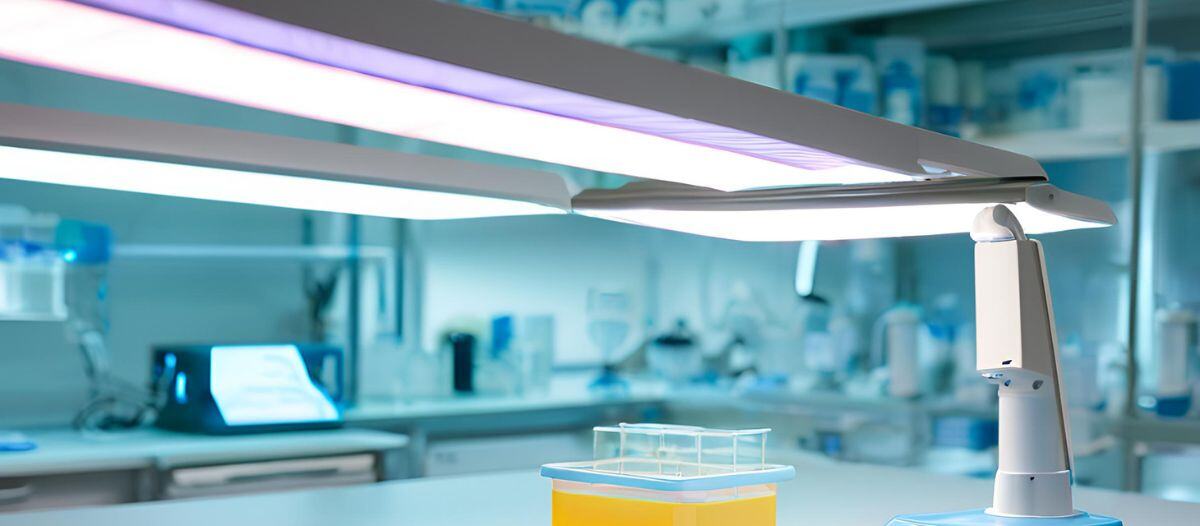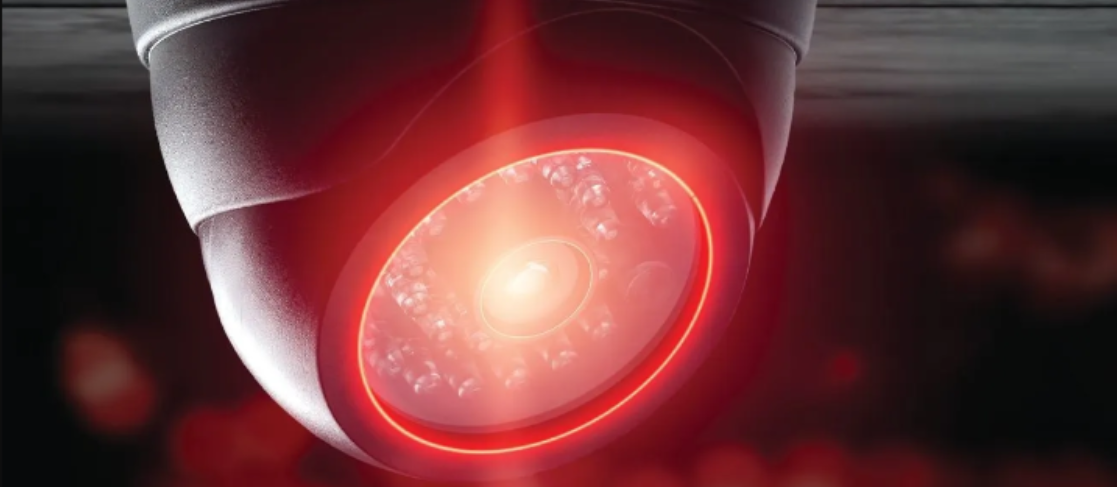UVC Lighting
Possibilities & pitfalls

During the COVID-19 pandemic, many facility managers and building owners explored new ways to eradicate germs and improve air quality in indoor spaces. One promising technique they identified is the integration of ultraviolet-C (UVC) light, which has antimicrobial features, into white-light illumination systems.
Ultraviolet light has wavelengths that range from 100 to 380 nanometers. The UVC subset of ultraviolet light, in contrast, ranges only from 200 to 280 nanometers. UVC light possesses potent germicidal properties, making it effective in deactivating microorganisms, including viruses and bacteria. Although UVC light has been integrated into air-handling units across a variety of building types for more than 50 years, integrations into white-light illumination systems represent a far more recent development.
One reason that air handling units make a logical target for integrations is that these units are typically housed in sealed-off equipment areas and protected with various safeguards, such as access control. White-light illumination systems, on the other hand, serve areas used by many people.
But if applied correctly, integrations into white-light illumination systems promote healthy, comfortable and safe environments. The benefits can be significant. For example, a whole-room simulation with a UVC lamp showed that the technology can reduce SARS-CoV-2 by 50 to 85 percent compared to ventilation alone.
But there are risks involved. UVC light can be harmful to the skin and eyes. It can degrade certain materials, and it can generate ozone, which can create breathing problems for sensitive people. A lack of careful planning and design can weaken efficacy. To overcome these challenges while promoting user comfort, FMs should pay attention to the following best practices:
Choose UVC sources wisely
Performance varies according to sources. Among the best choices are low-pressure mercury lamps or UVC LEDs. The latter are becoming increasingly popular because of their compact size, durability and efficiency. Other options include amalgam lamps, a special type of ultraviolet germicidal lamp that operates through a technology that regulates the mercury vapor pressure within. Because these amalgam lamps maintain a stable ultraviolet output at higher temperatures, they can be powered at higher wattages, generating more UVC for germicidal effectiveness.
Control emission wavelengths
It is essential to maintain precise control of the UVC wavelength output to ensure effective germicidal action while avoiding harmful ozone production. The following control strategies can be employed:
- Install UVC lamps that provide the correct wavelength - around 254 nm.
- Implement timer controls to regulate the duration of UVC exposure.
- Utilize occupancy sensors that can turn off the UVC lamps when people are present.
- Use remote control and monitoring systems to adjust the UVC lamp settings without direct physical access.
To further reduce ozone production, FMs should increase HVAC ventilation in rooms where UVC lighting is used.
Select appropriate optical systems
The most effective optical systems distribute UVC light evenly through a space while minimizing human exposure. Many of these systems rely on lens design, collimators (defined by Merriam-Webster as devices used for producing a beam of parallel rays), reflectors, diffusers or shields, along with proper placement of the lamp in the space. Strategies to find the right system and settings include:
- Consider the geometry of the space and properly place the UVC lamps for uniform coverage.
- Use collimators to control the spread of UVC light for precise directionality.
- Use diffusers or reflectors to spread the light uniformly.
- Use a smart-controls system to adjust the distribution of light.
Implement fail-safe measures
IoT can provide an extra layer of safety, through interlocks, motion sensors and occupancy detectors that deactivate UVC sources when people are present. In hospital operating rooms, for example, UVC lights in the ceiling fixtures turn off automatically whenever the rooms are being used. Some UVC lights in office restrooms turn off and on with entrances and exits.
In certain facilities, such as warehouses and factories with high ceilings, UVC lights can stay on even when areas are occupied. For instance, if employees are working on the floor or close to the floor, the lights can be directed upward and away from them. Consequently, the lights in these environments can stay on all day, every day if need be.
Such safety measures do not replace the basics; they supplement them. The basics include the training of workers to operate or maintain UVC white-light systems, the use of personal protective equipment (PPE) for these workers, and the placement of warning signs and labels where UVC systems are in operation.
Use monitoring and feedback systems
Sensors and feedback systems alert FMs when UVC lamps degrade or lose effectiveness, enabling prompt replacement of the lamps and maintenance of consistent disinfection levels. Some systems also send periodic reminders for staff to check on equipment based on its expected life cycle. The life expectancy of UVC lamps can vary based on the operating conditions, type of lamp used and other site-specific applications. Typically, UVC lamps have a life expectancy between 2,000 to 16,000 hours of continuous operation.
Approach space planning with care
It is critical to establish direct paths between the light sources and the areas targeted for germ-removal. UVC lighting situated above a shadowed space, like space under a conference table, will be ineffective. In such situations, it may be wise to install lights below the table.
But keep material in mind. Just as some outdoor furniture degrades or discolors after months of exposure to the sun, so will indoor furniture be exposed to UVC light for long periods of time. Certain materials, such as plastics, are more sensitive than others. Assessments of durability, therefore, should be factored into design decisions.
Comply with codes
All designs surrounding the use of UVC systems should comply with regulatory codes. Examples include the Underwriters Laboratories (UL) Certification, ASHRAE guidelines for air and surface disinfection, Illuminating Engineering Society (IES) standards related to the photobiological safety of lamps and lamp systems, national and international regulations from organizations like the U.S. Environmental Protection Agency and the International Electrotechnical Commission, and radiation safety authorities that regulate the use of UVC technology in certain regions.
Optimize white lighting
To maximize tenant comfort, FMs should choose the right white light. The illumination should mimic natural daylight through color temperature, color rendering and intensity. Glare and flicker should be minimized to prevent discomfort and eyestrain for occupants. Ideally, the illumination should offer dynamic control – the ability to adjust lighting levels to suit different tasks, times of day and occupant preferences. For aesthetic purposes, the UVC sources should seamlessly blend in with the white-light systems.
Benefits of Integration
Although the integration of UVC technology into white-lighting systems is a complex process, it is well worth the effort. Advantages beyond enhanced disinfection include:
- Cost-efficiency: By combining UVC lighting and white-lighting systems, FMs and building owners can achieve both illumination and germicidal benefits, optimizing the use of resources.
- Convenience: Occupants can enjoy comfortable lighting while benefiting from UVC disinfection, without any disruption to their daily activities.
- Versatility: UVC white-light systems can be applied in a variety of indoor environments, from health care facilities to residential spaces.
- Environmental conservation: By reducing the need for chemical disinfectants, UVC systems can contribute to a more sustainable and eco-friendly approach to indoor germ-reduction.
What’s next
Emerging technologies are further boosting the potential and promise of UVC lighting. One example is far-UVC lighting, which operates in the wavelength range of 200-220 nanometers. It possesses germicidal properties like traditional UVC but is less harmful to the skin and eyes. For this reason, it may eventually allow for 24/7 use in occupied spaces. Another example is the next generation of UVC LEDs. Researchers are working to equip them with higher output and longer lifespans. Finally, design teams can leverage AI and automation to adjust disinfection schedules based on occupancy and real-time data, resulting in better conservation of energy.
Although emerging technologies will improve the efficacy of integrations of UVC light into white-light illumination systems, there is no reason for FMs and building owners to wait. If they follow best practices, they can use these integrations to remove germs and improve air quality in indoor spaces. Tenants, occupants and visitors will appreciate these measures. Facility managers and owners, in turn, will appreciate the cost efficiencies that contribute to a high return on investment.

Harish Chopra, PE, LEED AP, is an associate partner in the Chicago office of global engineering firm Syska Hennessy Group.
References
nature.com/articles/s41598-020-76597-y
Read more on Operations & Maintenance , Technology and Risk Management
Explore All FMJ Topics









